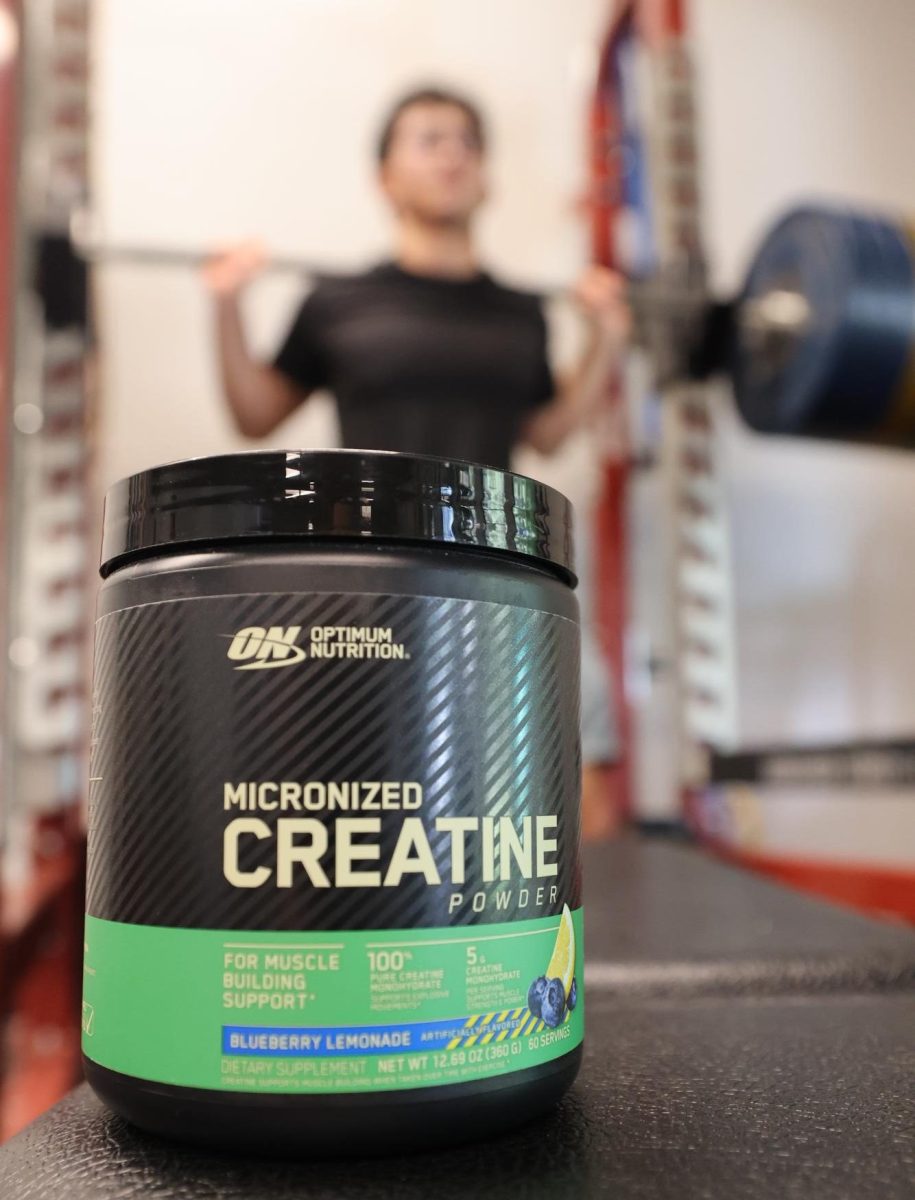
Liyang Zhuang ‘27
Rocco Vitale '26 loads up a 500 pound squat after taking creatine.
Creatine is a supplement commonly used among bodybuilders, but recently, it has been gaining widespread popularity, including among students at SHP. But what really is creatine, and what is its purpose? Why do students at the Prep take it, and what have they noticed about its effects? How can their answers help to better shape our understanding of this supplement?
According to the Mayo Clinic, creatine is a compound that is derived from three amino acids, glycine, arginine, and methionine. It is found naturally within the human body, with 95% of its stores located in skeletal muscle. When taken as a supplement, bodily reserves of creatine can increase by 15-40%. Creatine’s main purpose is to help recycle ATP—a molecule that cells use for energy—faster during high-intensity exercise, allowing individuals to sprint a little bit harder, pump out one or two more reps, or recover faster during rest periods. Over time, these small increases in intensity can compound to improve overall strength and endurance. In addition, studies from the national library of medicine show that individuals who take creatine see increases in lean mass, partly due to the retention of water in muscle tissue. An increase in creatine content leads to greater osmotic pressure in cells, allowing muscle groups to attain a bigger, fuller look.
Additionally, recent studies from the Aristotle University of Thessaloniki have shown that creatine may not only be useful for improving strength and endurance, but also cognitive function. Just as creatine helps to increase energy supply to muscles, it also increases the supply of energy to neurons in the brain. Several studies in long and short-term memory, reasoning skills, mental fatigue, and reaction time show creatine to have positive effects on individuals. It should, however, be noted that the Mayo Clinic found improvements were less present in studies including adolescents.
But what about students at the Prep? One student-athlete who recently began taking creatine is Sullivan Fischbein ‘28. Fischbein plays catcher for SHP’s varsity baseball team, and began taking creatine over the summer. He explained that he “wanted to go on a supplement that would increase muscle mass in a safe manner.” Fischbein says that he was recommended to take the supplement by his private strength coach and states that so far, he’s seen “an increase in muscle mass” and “higher energy when going to the actual workouts.” Fischbein “takes one scoop of creatine (5 grams) every day—in the morning with water.” He’s had no setbacks or side effects so far and was very positive overall about his creatine usage.
A student who’s taken creatine for about half a year and could be considered an intermediate creatine user is Thomas Rogers ‘28, who plays varsity football for SHP. Rogers began taking creatine in February and says he started taking it “because [his] older brothers had taken it and [he] is playing football, so [he] wanted to get bigger and see the benefits.” He says that, “[he] saw [himself] getting bigger like a month afterward” and “had some weightlifting improvement after [he] was taking it for a while.” He did list one negative as being “using the bathroom more because you have to drink more water.” Once again, Rogers was very positive about his use of creatine and plans on continuing his usage.
Finally, one of the most experienced weightlifters at the prep, Rocco Vitale ‘26, has taken creatine throughout his four years of high school. Vitale first heard about creatine from his dad, who he says “has been weight lifting for a long time and used creatine to boost his performance.” However, he says that he “never considered taking it until [he] started high school and began weight lifting.” Vitale states that his use of creatine is to “improve [his] performance in the gym and classroom” — citing the research mentioned previously. Over his athletic career and weightlifting journey, he’s taken creatine in cycles, “usually for a couple weeks at a time,” and takes “around 5 grams per day,” however he says this amount can change “depending on the amount of sleep [he] gets” — referring to other studies that have shown creatine’s ability to enhance alertness. Vitale gave an example of creatine’s impact on his bench press, stating that, “before taking creatine (in July), [he] was plateaued at 295 pound max bench press. After taking creatine consistently for a month, [he] increased [his] max bench press to 315 pounds.” This impressive feat is something that even some of the most experienced lifters struggle to achieve. It becomes even more staggering when Vitale’s age and rapid increase in strength are taken into account. While this is a testament to Vitale’s focus, consistency, and determination, he also states that “the circumstances of the situation” point to creatine’s usefulness, as he managed to hit this milestone “while being on [a] cut over the summer, which is known to inhibit progress on bench press.” Overall, Vitale had nothing negative to say about his experience with creatine, stating no negative side effects in his use.
All three of these students who take creatine reported it as an entirely positive supplement that benefitted their physical and cognitive function. While scientific studies on creatine usage in adolescents are limited, the information we have aligns with the anecdotes of Fischbein, Rogers, and Vitale. Of course, the effects of creatine will vary, and it is necessary to consult with a medical professional before taking a supplement. However, based on the available medical research and anecdotal evidence of SHP, creatine seems to be a useful option for students and athletes alike.